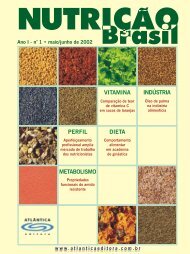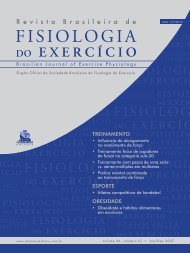Fisiologia do Exercicio_2005.pdf - Jean Peres
Fisiologia do Exercicio_2005.pdf - Jean Peres
Fisiologia do Exercicio_2005.pdf - Jean Peres
You also want an ePaper? Increase the reach of your titles
YUMPU automatically turns print PDFs into web optimized ePapers that Google loves.
Revista Brasileira de <strong>Fisiologia</strong> <strong>do</strong> Exercício - Volume 4 Número 1 - janeiro/dezembro 2005<br />
na-angiotensina, bem como nas respostas vasculares. As<br />
estruturais envolvem a modifi cação da estrutura vascular<br />
muscular, incluin<strong>do</strong> o remodelamento vascular como o<br />
aumento da fl exibilidade, aumento da área de passagem <strong>do</strong><br />
fl uxo sangüíneo e/ou diâmetro das artérias e veias, e ainda<br />
a angiogênesis.<br />
Por fi m, cabe ressaltar que os programas de prescrição<br />
de exercícios podem ser caracteriza<strong>do</strong>s em formais ou intramuros<br />
e não-formais ou extramuros. Os programas formais<br />
apresentam como vantagem o maior controle das atividades<br />
prescritas e das respostas fi siológicas, o que pode ser interessante<br />
de acor<strong>do</strong> com o risco <strong>do</strong> indivíduo. Em contrapartida,<br />
programas com essas características, não tem se mostra<strong>do</strong>s<br />
efetivos para manter a adesão <strong>do</strong>s praticantes após a alta.<br />
Nos programas não-formais a prescrição é simples, existin<strong>do</strong><br />
menor controle das atividades. Não é necessária a presença<br />
de um profi ssional especializa<strong>do</strong> conduzin<strong>do</strong> todas as sessões<br />
de treinamento. Uma das maiores vantagens desse tipo de<br />
programa é a autonomia que ele tende a gerar nos praticantes.<br />
Cabe ressaltar que não existe a melhor forma de treinamento.<br />
Dependen<strong>do</strong> de aspectos como as características clínicas e<br />
funcionais, bem como as condições para a prática <strong>do</strong> exercício,<br />
a opção deve ser feita.<br />
Referências<br />
1. Van den Hoogen PC, Seidell JC, Menotti A, Kromhout D.<br />
Blood pressure and long-term coronary heart disease mortality<br />
in the Seven Countries study: implications for clinical practice<br />
and public health. Eur Heart J 2000;21:1639-42<br />
2. Vasan RS, Larson MG, Leip EP et al. Impact of High-normal<br />
blood pressure on the risk of cardiovascular disease. N Engl J<br />
Med 2001;345:1291-97.<br />
3. Joint National Committee on Detection, Evalution, and Treatment<br />
of High Blood Pressure. Th e seventh report of the Joint<br />
National Committee on Detection, Evalution, and Treatment<br />
of High Blood Pressure. (JNC VII). Arch Intern Med 2003.<br />
4. Organização Mundial da Saúde. Organização Pan-Americana<br />
de Saúde. Avaliação <strong>do</strong> plano de reorganização da atenção à<br />
hipertensão arterial e ao diabetes mellitus no Brasil. Brasília:<br />
MS; 2004. 63 p. il. Color (Série C. Projetos, Programas e Relatórios).<br />
5. Mion D, Macha<strong>do</strong> CA, Gomes MAM et al. IV Diretrizes<br />
Brasileiras de Hipertensão Arterial. Arq Bras Cardiol 2004;82<br />
(suplemento IV).<br />
6. Appel LJ; Moore TJ; Obarzanek EA. Clinical trial of the effects<br />
of dietary patterns on blood pressure. New Eng J Med<br />
1997;336:1117-1124.<br />
7. He J, Whelton PK. Epidemiology and prevention of hipertension.<br />
Med Clin North Am 1997;5:1059-1077.<br />
8. Pescatello LS, Barry A, Fagard RMD et al. Exercise and hypertension.<br />
Med Sci Sports Exerc 2004;36(3):533-553.<br />
9. Kaplan et al. Task Force 5: Systemic Hypertension. J Am Coll<br />
Cardiol 2005; 45:1346–8.<br />
10. Pescatello LS, Bairos L; Vanheest JL et al. Postexercise hypotension<br />
diff ers between white and black women. Am Heart J<br />
2003;145:364-370.<br />
55<br />
11. Forjaz CLM, Santaella DF, Rezende LO, Barreto ACP, Negrão<br />
CE. Exercise duration determines the magnitude and duration of<br />
pos-exercise hypotension. Arq Bras Cardiol 1998;70:99-104.<br />
12. Kenney MJ, Seals DR. Postexercise hypotension: key features,<br />
mechanisms, and clinical signifi cance. Hypertens 1993;22:653-<br />
664.<br />
13. Mion D, Macha<strong>do</strong> CA, Gomes MAM et al. IV Diretrizes<br />
Brasileiras de Hipertensão Arterial. Arq Bras Cardiol 2004; 82<br />
(suplemento IV).<br />
14. Kelley GA, Kelley KS, Tran ZV. Aerobic exercise and resting<br />
blood pressure: a meta-analytic review of ran<strong>do</strong>mized, controlled<br />
trials. Prev Cardiol 2001;4:73-80.<br />
15. Paff enbarger Junior RS, Wing AL, Hyde RT, Jung DL. Physical<br />
activity and Incidence of hypertension in college Alumni. Am<br />
J Epidemiol 1983;117:245-257.<br />
16. Haapanen NS, Miilunpalo I, Vuori PO, Pasanen M. Association<br />
of leisure time physical activity with the risk of coronary<br />
heart disease, hypertension and diabetes in middle-aged men<br />
and women. Int J Epidemiol 1997;26:739-747.<br />
17. Hayashi TK, Tsumura C; Suematsu K; Okada S; Fujii, En<strong>do</strong><br />
G. Walking to work and the risk for hypertension in men: the<br />
Osaka health Survey. Ann Intern Med 1999;130:21-26.<br />
18. Folsom AR, Prineas RJ, Kaye AS, Munger RG. Incidence of<br />
hypertension and stroke in relation to body fat distribution and<br />
other risk factors in older women. Siroke 1990;21:701-706.<br />
19. Pereira MA, Folsom AR, Mcgoverns PG et al. Physical activity<br />
and incident hypertension in black and white adults:<br />
the Atherosclerosis Risk in Communities study. Prev Med<br />
1999;28:304-312.<br />
20. Hayes DL, Barold SS, Camm AJ, Goldschlager NF. Evolving<br />
indications for permanent cardiac pacing: an appraisal of the<br />
1998 American College of Cardiology/American Heart Association<br />
Guidelines. Am J Cardiol 1998; 1;82(9):1082-6.<br />
21. Legato MJ. Cardiovascular disease in women: gender-specifi c<br />
aspects of hipertension and the consequences of treatment. J<br />
Womens Health 1998;7(2):199-209.<br />
22. Romundstad S, Holmen J, Hallan H, Kvenild K, Ellekjaer H.<br />
Microalbuminuria and all-cause mortality in treated hypertensive<br />
individuals: <strong>do</strong>es sex matter? Th e Nord-Trondelag Health<br />
Study (HUNT), Norway. Circulation 2003;108(22):2783-9.<br />
23. Kokkinos PF, Narayan P, Colleran JA et al. Eff ects of regular<br />
exercise on blood pressure and left ventricular hypertrophy in<br />
African-American men with severe hypertension. N Engl J Med<br />
1995;333:1462-67.<br />
24. Blair SM, Goodyear NN, Gibbons LW, Cooper KH. Physical<br />
fi tness and incidence of hypertension in health normotensive<br />
man and women. JAMA 1984;252:487-90.<br />
25. Fagard RH. Exercise characteristics and the blood pressure<br />
response to dynamic physical training. Med Sci Sports Exerc<br />
2001;33(suppl):S484-92;discussion S 493-94.<br />
26. Jennings GL, Deakin G, Korner P, Meredith I, King Well B,<br />
Nelson L. What is the <strong>do</strong>se-response relationship between exercise<br />
training and blood pressure? Ann Med 1991;23:313-18.<br />
27. Hagberg JM, Goldring D, Ehsani AA et al. Eff ect of exercise<br />
training on the blood pressure and hemodynamic features of<br />
hypertension a<strong>do</strong>lescents. Am J Cardiol 1983;52:763-768.<br />
28. Cleroux J, Feldman RD, Petrella RJ. Lifestile modifi cations to<br />
prevent and control hypertension. CMAJ1999;160(9):521-<br />
528.





